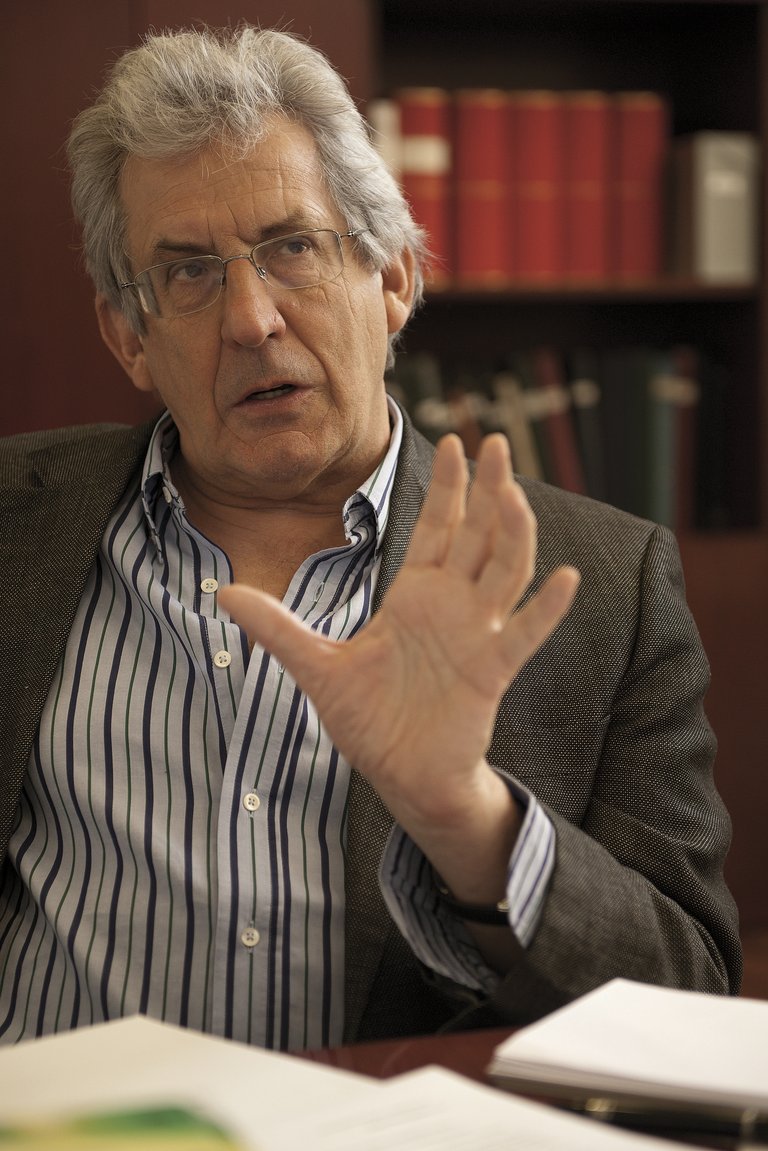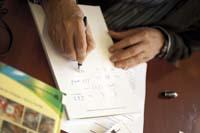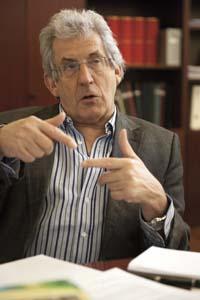"The DIPC helps San Sebastian appear on the map

The initial objective was to offer the leading groups within the university, especially those of material physics, the possibility of opening up internationally, but without the bureaucratic obstacles imposed by the system of officials. Then, the dynamics of the project and the quality of young people have gone beyond, I did not expect so much success. And I had more expectations than my companions!
I am accompanied by Colmenero on one side and Alberto L fish Basagunen on the other. Alberto is a professor of constitutional law.
Good ideas have a life of their own. We started with the DIPC, then came the idea Fellows Gipuzkoa, a platform for researchers out here to come back here. In short, we wanted to expand science internationally with a new mechanism that would allow us to compete with the best teams in the world. And, besides opening up internationally, the goal was to transmit it to society, to which we gave it much importance.
Not all large research groups have the same structure, but they have some things in common. Institutional flexibility, that is, autonomy in decisions. The university groups do not enjoy this autonomy by the regulation system and officials.
The DIPC is born as a strategic agreement between the public sector and the private sector. That's important. It is a model of its own. It has no fixed post. The fixed positions are located in the centers of the environment of the DIPC. A community has been created around the DIPC of which part is internal, researchers from the Department of Materials Physics of the UPV and other groups within the university. They are hosts for the external community of the DIPC, that is, for the coming international researchers.
Little in Europe, with a similar organization in the Centre of Trieste, but with many local researchers and us not. In the United States they can be UC Santa Bárbara Physics or Aspen Center for Physics. Ours is a very small and economic idea because the internal community of the DIPC is in the UPV itself. This feature has been fundamental in the success of DIPC. UPV/EHU is part of DIPC, but DIPC is not a university institute.
On the other hand, the Board is of high level, it is not people who are under someone, which causes speed in decision-making. And also, the quality of the internal community of DIPC is very good. And that internal quality attracts the external community: more than a thousand researchers have been working on stays of more than a month in the last ten years. It is a very strong community, and that means we are very protected by any project we organize.

Yes. We have four broad lines of research: electronic interactions, soft matter, photonics and surface physics. In fact, from the point of view of research, DIPC is a very simple organization that aims at basic research, yes, at a high level. Nanogune, for example, is more complicated, they have to turn their ideas into products, but we don't.
However, the world's largest organizations are characterized by the lack of economic independence of the DIPC. The endowment or endowment of the DIPC, that is, a capital with sufficient interests to finance, is very small.
The University of Harvard, with less than 4,000 students, had a endowment of 38,000 million dollars before the crisis of 2007. Only by taking interest of 5% to that money, it annually obtains almost 2,000 million dollars for the ordinary budget. We have four centers here and we believe we will swallow the world. But with our budgets we cannot compete with Harvard. To get an idea, the budget of the UPV/EHU amounts to about 500 million dollars. However, in what we do we have to be like Harvard. There is no secondary science, they will not allow us a worse science because our budget is lower. The budget of the DIPC is also very low, I would like to get between 30 and 50 million euros. To see if some rich Basque leaves us his money, we will use it perfectly (laughter).
In this society it is impossible, but the tendency can change. In the United States it is different. There the wealthy do not leave all the money to their children. The example is Bill Gates, who has created a foundation with a high percentage of his fortune. Gordon Moore, founder of Intel, donated a third of his money to Caltech. Surely here there are no adequate cultural or fiscal or social conditions for this to happen. And without economic independence, we have a great dependence on the administration of the time. But it is good that at least part of the budget comes from the interests of the endowment.
It has helped Donostia to appear on the scientific map. And has contributed to creating the goal of the Donostia City of Culture project: Donostia, besides making a city of science, doing science in the city. In the field of Basque, in addition, together with the Elhuyar Foundation, we will carry out various activities.
In 2000 they gave me the gold medal of San Sebastian. And in my speech I said that I would like to put among all good foundations in a not too distant future for San Sebastian to be known as a city of science and technology and have international recognition.
The DIPC has also brought wealth to the city. The arrival of 1,228 researchers has meant a great hotel wealth, for example. Many of them have been paid to us, but others have paid their stay with their money. We are increasing the number of visits. In the congresses of the DIPC we have participated 5.083 people, of which 3.500 are from outside Donostia.

For this purpose we launched the Fellow Gipuzkoa program. They are platforms of recovery of researchers that allow those who return to develop their personal curricula with total freedom. All participants in this program have subsequently obtained jobs. For example, Ricardo D no Mui or deputy director of the CSIC was the first "fellow Gipuzkoa". This program is the catalyst of the UPV/EHU (a food point of the mixed center) and has been a support to the international policies of the Basque Government. Therefore, DIPC is a center that has attracted talent. The Nanogune centre is also an intellectual contribution of the DIPC.
First of all, the number of publications, which in 2009 tripled those of the year 2000. In total, in these ten years we have published 1,192 articles, being the number of quotes from our articles over 17,500. We have achieved an average of 15 appointments per article, which is very difficult in physics. In addition, we have organized 432 seminars and 51 congresses. We are now launching the DIPC television. There you can see our conferences. It is still very static, but we want to give great importance to this project.
Yes. We have already carried out four major outreach actions: Seminar "Frontiers of Science" (together with secondary school teachers), year of Einstein, ATOM BY ATOM congress and the one that comes now. It is called "Passion for Knowledge" and will be a great congress. I will preside over the congress and Juan Colmenero and Alberto L pez Basaguren will accompany me. It will have a very broad scientific program, with lectures by local scientists, Nobel laureates and people from other fields. For example, there will be intellectuals members of Jakiunde, such as musician Luis de Pablo and writer Bernardo Atxaga. The goal of this congress is to attract people.
Extremely dangerous, because today's society is very based on science and technology. It is surprising that in a society of these characteristics few people want to do science and technology. We have to change this, if we don't finish with the hen of the golden eggs. It is a problem of Western society. Asia does not have that problem, we do, and we have to solve it.
Yes, yes. And if we consider disclosure, I would say that at least 60% of my time is for physics. About 20% of my time dedicated to dissemination. Now I am focusing on the creation of Jakiunde and, however, I have time for physics. That's because I have many collaborators and they are very good. They are many. It is necessary, in general we work a lot in collaboration with others and in network. In addition, it is very important to care for people, many people say it, but few do it really. But I think the key to collaborations is caring for people. I am an expert in collaborations because I have worked with many people. In a collaboration, if someone claims ownership of an idea after five days, that person is not willing to collaborate. In a good collaboration the ideas are of everyone.
Buletina
Bidali zure helbide elektronikoa eta jaso asteroko buletina zure sarrera-ontzian











